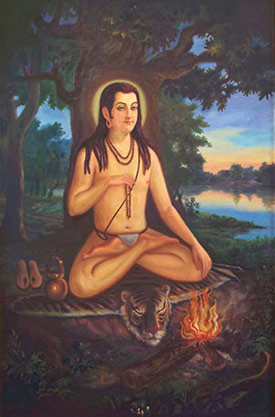
Udasinacharya Shrichandraji
(1494 - 1643)
Udasinacharya Shrichandraji was one of the greatest exponents and masters of the ancient Udasin lineage. Popularly called Baba Shrichandraji, he was a great ascetic yogi, Vedic scholar, inspired poet, nationalist, social reformer, and above all, a great enlightened sage. He was the eldest son of Shri Guru Nanak Devji, the great spiritual master and the first Sikh Guru. He was born in the village of Talwandi of Tehsil Khadagpur in Lahore (now in Pakistan) in 1494. Because of his fame, Shrichandraji is often mistakenly taken to be the founder of the Udasin tradition. In fact he was the 165th great exponent in this ancient lineage.
Many, many extraordinary incidents and miracles are associated with Shrichandraji. From the very beginning he was naturally much inclined towards meditation and solitude, and even as a child he loved to go to the nearby forest to meditate. Many a time he was seen absorbed in deep meditation amidst wild animals. At the tender age of eleven, he went to live in Kashmir and within a period of seven years he had mastered all the Vedas, Puranas and other scriptures from Pandit Purushottam Kaul. It was in Srinagar, Kashmir, that Babaji received initiation into the Udasin tradition from the great Udasin saint, Avinashi Muni. He did intense austerities and sadhana in Kashmir and travelled extensively all over India.
Baba Shri Chandraji's life is an unending story of supernatural incidents, great sacrifice, renunciation, austerity and selfless service to society. In Kashmir, he brought back to life the dead child of a Brahmin, who later became one of his main disciples by the name of Balhas. Hearing of his spiritual stature and supernatural powers, the then ruler of Kashmir, Yakub Shah, came to have the darshan of Shrichandraji. Deeply impressed by his divine personality, Yakub Shah donated about forty acres of forest land to Babaji. That place has since become very holy for the Udasins and the historical Chander Chinar Ashram was founded there. The affairs of this ashram are managed by a trust, currently headed by Shri Chandra Swamiji Udasin.
Babaji remained on this earth for 149 long years. It is believed that throughout his life he retained his divinely charming youthful physical features. He travelled extensively to all parts of India and even to many other Asian countries to awaken people from their slumber and instil righteousness and true spirituality in them. He hit hard against social evils, religious dogmas and superstitions, and united the society, divided by narrow sectarianism. He went on pilgrimages to all the main pilgrim centres of the country, but his main field of activity was the border area of India, Kashmir, Punjab, Nepal, Peshavar, Sindh and Kandhar (Afghanistan).
He wrote scholarly treatises on the Vedas called Shrichandra Bhashya in which he propounded his philosophy of combining knowledge and devotion as a means of God-Realization. Unfortunately these are not available now. Babaji was a great scholar of Sanskrit, Hindi, Persian, and Punjabi and was an inspired poet. He wrote a huge volume of spiritual poetry. Matra, written in 39 short verses, is very famous and is revered like the Vedas in the Udasin order. It contains the pointers in seed form to moral and spiritual progress. It also shows, through the prevalent symbols of his time, the real nature of spirituality and the secret of God-Realization.
Babaji believed in and preached that the Absolute Divine Truth is One without a second. Along with numerous Hindu kings, many Muslim rulers also had great reverence for Babaji. King Humanyu and Jahangir came to have his darshan. He protected the Hindu masses against forcible religious conversions and preached brotherhood amongst Hindus and Muslims. Besides this, Babaji was a powerful link between the Vedic Hindu religion and the glorious tradition of the Sikh Gurus. After Shri Guru Nanak Devji, all the Sikh Gurus up to the sixth Guru, Shri Hargovind Devji, used to come to Babaji for his darshan. Although outwardly Baba Shrichandraji's life and that of his great father, Guru Nanak Devji, was different, because the former was a monk and the latter a householder, both are considered divine souls. In the Udasin tradition, Guru Nanak Devji is regarded as an incarnation of Lord Vishnu and Baba Shrichandraji, that of Lord Shiva.
There were five main centres established by Babaji: Baratha Sahib (Punjab), Srinagar (Kashmir), Kandhar (now in Afganistan), Thattha (now in Sindh Pakistan) and Peshavar (now in Pakistan). When the time of Babaji's departure from this earthly life arrived, he appointed four of his close disciples, Kamlasan, Balhas, Govind Dev and Pushpa Dev, as his successors at different places. As is commonly believed, in 1643, he crossed the river Chamba (now in Himachal Pradesh) sitting on a huge stone boulder which floated on the water by his yogic power. He then disappeared into the forest, never to be seen again. That huge stone is still located and worshipped in the sanctum sanctorum of a temple dedicated to Babaji in Chamba.
Wherever Babaji visited and performed his lilas (divine play), maths and deras have been constructed in his honour. Because of his powerful divine personality, the Udasin tradition was revived. Today there are thousands of Udasin ashrams and temples of Baba Shrichandraji in India. Udasin monks are often considered quite liberal. Besides spiritual sadhana, they are engaged in social service activities in the fields of medical aid, education, relief to the poor and destitute, etc.
An authentic and detailed biography of Acharya Shrichandraji can be found in the book Shraut Muni Charitamrit written in Hindi by the great Udasin sage late Swami Gangeshvaranandaji. The book is published by Swami Gangeshvar Foundation, c/o Guru Gangeshvar Dham, Karol Bagh, New Delhi.

